Samsung Galaxy S 5 Review
by Anand Lal Shimpi & Joshua Ho on April 8, 2014 12:00 AM EST- Posted in
- Smartphones
- Samsung
- Mobile
- Galaxy S 5
Display
As the smartphone market continues to mature, the distinguishing between smartphones becomes harder and harder as OEMs continue to converge in platform and in most other aspects. This is most evident when looking at the progression from the Galaxy S2 generation to today. Back then, the Galaxy S2 was notable because of its Exynos 4210 SoC, which was far ahead of Qualcomm’s dual core Scorpion solutions at the time, which meant non-Samsung OEMs had notably worse CPU and GPU performance. The same was also true for the original Galaxy S with its Hummingbird SoC. Today, just about every OEM ships the same SoC. The difference between 8974AB and 8974AC is effectively only an eight percent CPU bump for the AC variant.
One of the key differentiators now in the market is display. The Galaxy S 5 features a 5.1-inch 1080p Full HD Super AMOLED display, equipped with the usual set of software defined color profiles. The GS5 gets a new adaptive profile that automatically adjusts the tint of the display according to the color of the ambient light. It's a neat effect, however Samsung's Cinema mode still ends up being the most accurate.
As always, we measure color accuracy using Spectracal’s CalMAN 5 software and a custom workflow for smartphones and tablets.
The results show that the Galaxy S5 has a display that is dramatically improved from the Galaxy S4. However, the Galaxy S line doesn’t exist in a vacuum, so it’s important to also look at how it compares against the best LCDs in other phones. In this department, things aren’t quite as perfect. To start, the color gamut control is still rather poor even on Cinema mode, as effectively all of the secondary colors miss the sRGB targets for saturation sweep. Yellow, cyan secondaries and green primaries are also notably out of the sRGB gamut triangle. While recent headlines have raved about the Galaxy S5’s record-setting color accuracy, I don’t see this at all in the results. Still, against the competition in the Android space, Samsung has improved a tremendous amount while other OEMs seem to be stagnating or even regressing in color accuracy. The only Android OEM that actually beats Samsung in the color accuracy department is now Google, which is strange because they contract out their hardware to other Android OEMs.
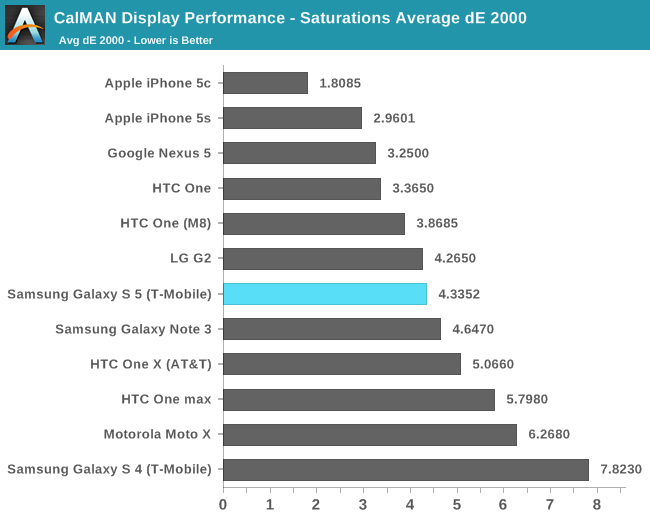
Looking at the saturation sweep, it’s evident that Samsung is now about equivalent to LG in color accuracy for their displays. HTC is barely ahead, with such a small difference that it’s not worth counting. Only Google and Apple have a noticeable lead in this department, a huge improvement from 2013 when Samsung trailed far behind most other competitors in this test.
In the Gretag Macbeth Colorchecker, Samsung continues to hold its position, beating all but Google and Apple. HTC is noticeably behind in this department compared to Samsung, as the One (M8) is horrific in this department compared to even the original HTC One.
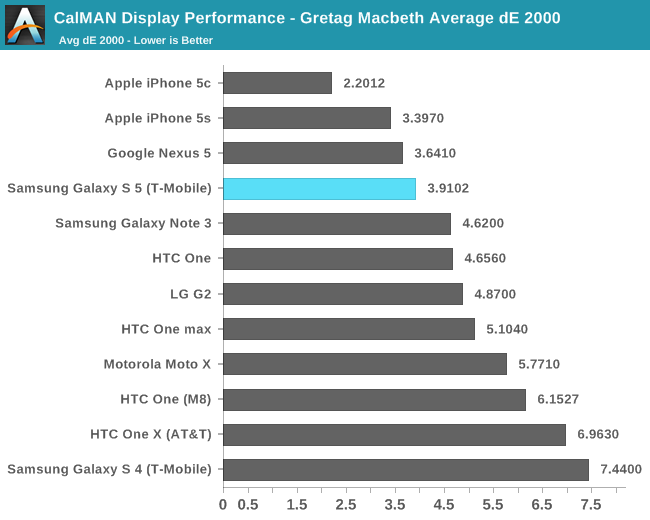
In the contrast department, Samsung continues to dominate, with effectively infinite contrast. Based upon some quick viewing of the display in the darkest room I have in the house, I don’t see any obvious DC bias issues. Unfortunately, I still see some ghosting on the display at low brightness which manifests as a purple trail when scrolling. This seems to be unchanged from the Galaxy S4. The minimum white brightness is around 1.8 nits, which is great for reading at night, as many LCD-screened phones such as the LG G Pro 2 have a minimum white brightness of around 7-12 nits.
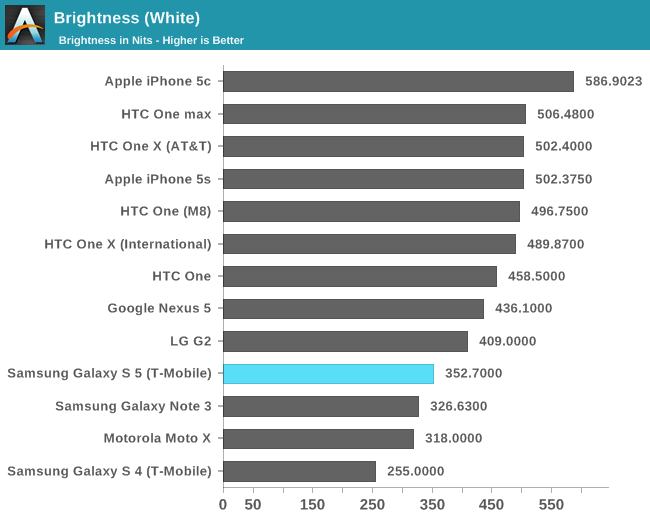
Samsung has also made great gains in the maximum brightness department, which is especially pleasing because for the longest time, AMOLED was noticeably less bright which made it incredibly difficult to read webpages and similar content outdoors. I’m happy to say that this is no longer the case, as the Galaxy S5 now has a display that realistically reaches around 440 nits outdoors with a pure white image, although this requires auto-brightness to be on and will vary with the screen mode. The maximum that is accessible without this daytime boost mode is somewhere around 350 nits.
The problem is the way Samsung has achieved this, something that is shown in the grayscale tests. While Samsung has done a great job in clamping down the white point to around 6504k, grayscale is so noticeably green that not only does CalMAN show this in the measurements, but also casual observation. I can literally see that the grayscale image is not gray, but an off-green. I’m not quite sure how this happened, but I suspect that this was done in an effort to increase peak brightness as even in the bluest display mode, green is still closely tracking with blue.
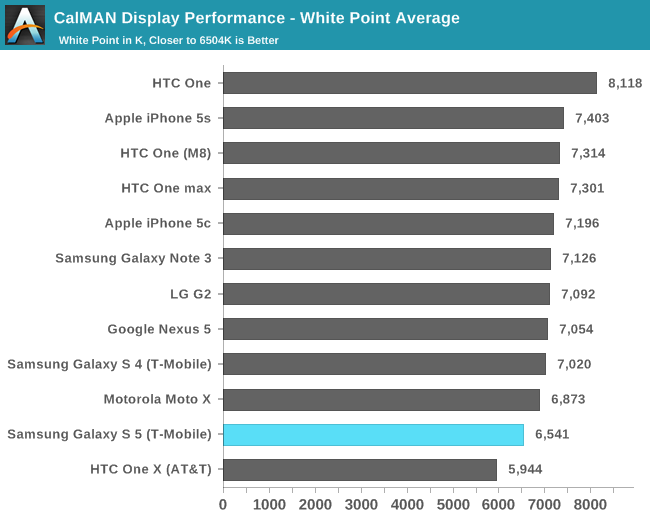
Overall, I’m quite pleased with the display. The AMOLED display in the Galaxy S5 is finally equivalent to LCD displays in color accuracy and peak luminance, areas that LCD used to be the best in. Throw in the incredible contrast that AMOLED has always had and the ability to toggle between wide color gamut and accurate color, and I would say that AMOLED is finally equal, if not slightly better than LCD. With a few more iterations, I wouldn’t be surprised if I were to write that AMOLED is clearly superior to LCD. Of course, there are some issues such as a noticeable green tint to the display in grayscale and Samsung still needs to improve their clamping of gamut to sRGB for Cinema/Movie mode, but none of these issues seriously detract from the viewing experience.


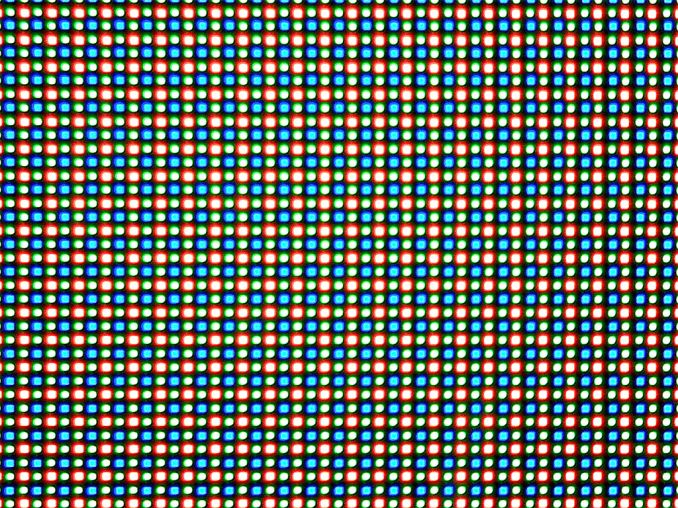












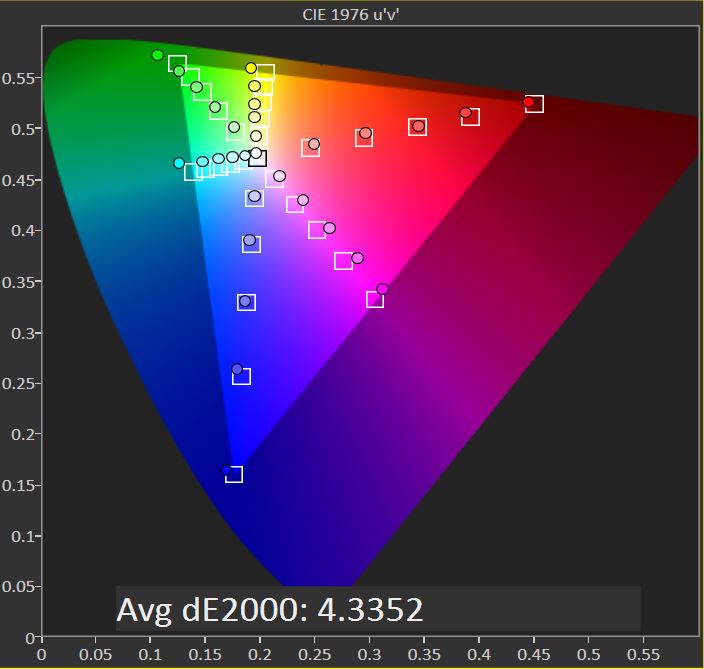
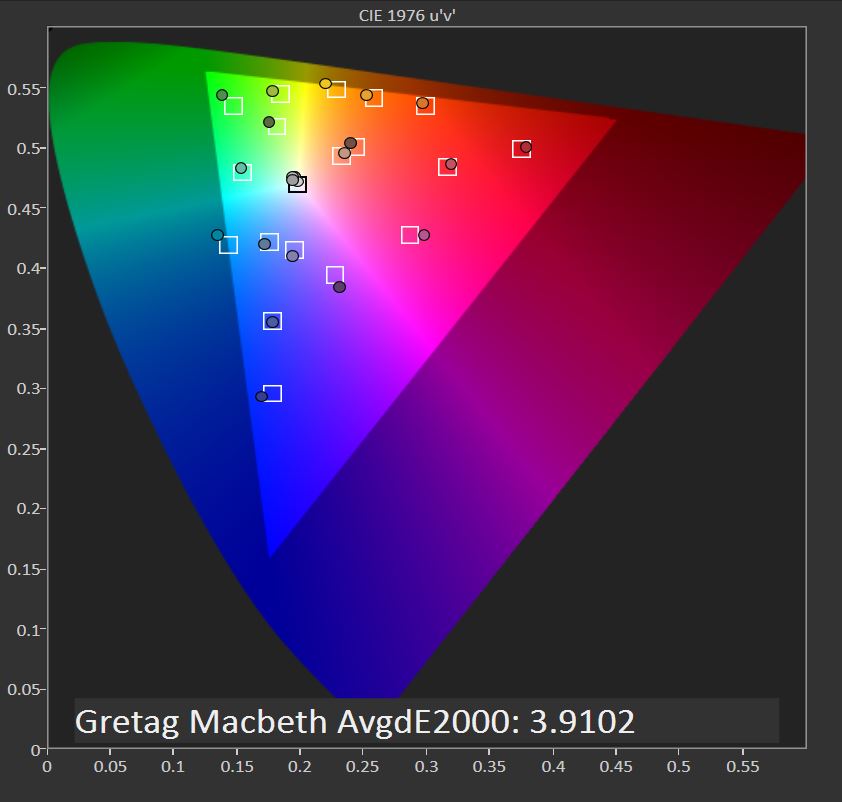
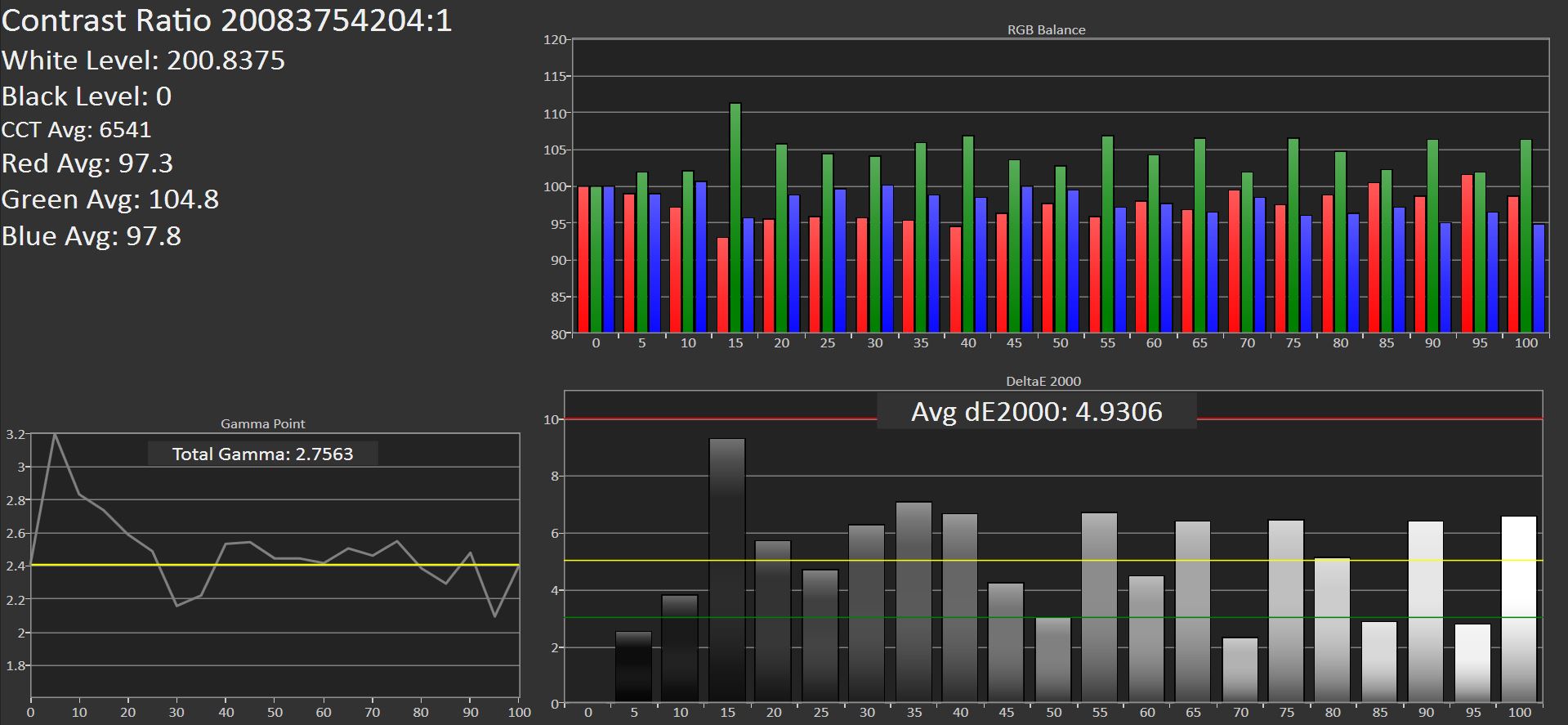








296 Comments
View All Comments
xsoft7 - Tuesday, April 8, 2014 - link
just remove the touchwiz UI!every single samsung device has lags because of it!
after installing google edition\diffrent roms that not based on it, the lags dissappeard!
the UI is their most weak point, no matter how fast the cpu\gpu or ram will be, the ui, after several software insallation will L-A-G. just go over youtube and see it for yourself! wether it is GALAXY note 1,2,3 or galaxy s 12345, or tabs. they are lagging! (except google edition)
BedfordTim - Tuesday, April 8, 2014 - link
That is a deliberate feature put there so that you will upgrade to a "faster" phone.theduckofdeath - Tuesday, April 8, 2014 - link
The GS4 is the most stable phone of 2013. People who has actually held a phone know that people like you and xsoft7 are just trolling.http://www.androidcentral.com/apps-crashed-most-gi...
Give it up. No one cares about your opinion.
theduckofdeath - Tuesday, April 8, 2014 - link
*People who has actually held a GS4 know....Astarael - Tuesday, April 8, 2014 - link
*havenoel_newell - Friday, October 3, 2014 - link
In my opinion Galaxy S5 does not reach up to the same level as the competition, even from other Samsung phones (see http://www.consumertop.com/best-phone-guide/ ). For example HTC One M8 and Motorola Moto G are fantastic. But we can agree on one thing – Galaxy S5 wipes iPhone off the table any time of the day.earthrace57 - Tuesday, April 8, 2014 - link
I hate to break it to you, but how stable it is when using apps isn't exactly relevant when using touchwiz. On my friend's S4, there is noticeable slowing when doing motions in the basic UI, which is what we are talking about.theduckofdeath - Tuesday, April 8, 2014 - link
I hate to break it to you, every phone, no matter brand or OS can be slow if you install the wrong apps.Your "friends" phone is completely irrelevant to everybody who's actually used a GS4. Because we know you just full of it. How do I know I am more right than you? Because I know which Android phone is dominating sales. By a gigantic margin. If anything of what you're making up is true, Samsung wouldn't be as dominant, no matter how much money they would throw at their marketing department.
niva - Tuesday, April 8, 2014 - link
Dominating sales has nothing to do with what you're describing. Have you tried the google play version of the galaxy s? The one that comes with stock android and doesn't feature the silly overlays? Yup, runs more stable than the "regular" galaxy s and actually gets updated in terms of software.The reason why manufacturers drop those skins is not so they "look different" only but because they can somehow rationalize not updating the software on the device later and force you into an upgraded device sooner.
Anyone buying a non-nexus phone is in this boat unless they want to do some work on their own to keep the devices up to date and that doesn't always quite work out right in terms of stability.
darwinosx - Tuesday, April 8, 2014 - link
Even Nexus phones are not always updated immediately as we have seen in the last year.